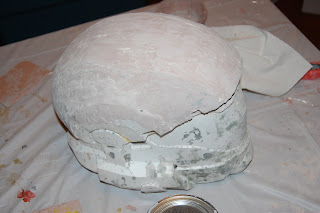I really don't have alot of bondoing experiance, but in the helmet project I discovered in the process of just painting it on and sanding it off, painting it on and sanding it off painting it on and sanding it off... well, lets just say it gets really repetitive, but just remember this "Yes it maybe more expensive per gallon that gasoline, but you have to pretend you own a HUMMER and go all out." - me. It gets expensive but here are some helpful tips to make it cheaper:
1.) paint it on smooth the first time, and you wont have to do as many coats
2.) stir slowly when mixing the hardener, to keep the bondo from getting bubble in the middle (you'll have to fill them in later if you don't)
3.) the entire helmet doesnt have to be covered in bondo, only the parts that are rough and need to become smooth
4.) youre not making the helmet strong with the bondo, youre just making it smooth, so your finished product should be relatively thin.
5.)when sanding use a coarse sand paper to file down all the crap that you dont want, then use a finer sand paper to make it smooth and exact.
keep that in mind and your bondo experience will be much more pleasant.
Here are some pictures of my process

covered the top
all sanded down






